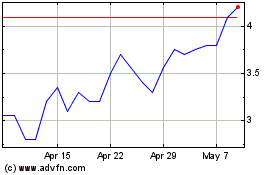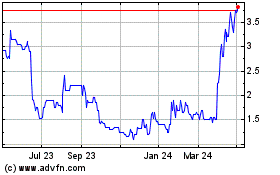TIDMEST
RNS Number : 5264C
East Star Resources PLC
12 October 2022
THIS ANNOUNCEMENT CONTAINS INSIDE INFORMATION FOR THE PURPOSES
OF ARTICLE 7 OF REGULATION 2014/596/EU WHICH IS PART OF DOMESTIC UK
LAW PURSUANT TO THE MARKET ABUSE (AMMENT) (EU EXIT) REGULATIONS (SI
2019/310) (" UK MAR"). UPON THE PUBLICATION OF THIS ANNOUNCEMENT,
THIS INSIDE INFORMATION (AS DEFINED IN UK MAR) IS NOW CONSIDERED TO
BE IN THE PUBLIC DOMAIN.
NOT FOR RELEASE, PUBLICATION OR DISTRIBUTION, IN WHOLE OR IN
PART, DIRECTLY OR INDIRECTLY IN OR INTO THE UNITED STATES,
AUSTRALIA, CANADA, JAPAN, THE REPUBLIC OF SOUTH AFRICA OR ANY OTHER
JURISDICTION WHERE TO DO SO WOULD CONSTITUTE A VIOLATION OF THE
RELEVANT LAWS OF SUCH JURISDICTION.
12 October 2022
East Star Resources Plc
("East Star" or the "Company")
Drilling to Commence on Rare Earths Project, Kazakhstan
East Star Resources Plc (LSE:EST), the Kazakhstan-focused gold,
rare earths and copper explorer, is pleased to announce that all
necessary approvals to commence fieldwork at the Talairyk heavy
rare earths (HREE) project in the Kostanay region of Kazakhstan
have been received and drilling will commence imminently - several
months ahead of schedule.
Highlights:
-- 1,000m of Reverse Circulation (RC) drilling to confirm
historical grades of the Ionic Adsorption Clay (IAC) hosted
deposit
-- Samples to be sent for ICP analysis and leach test work to
confirm historical grades and the potential for economic recovery
of rare earth elements
-- Approvals from government authorities to commence fieldwork
received much faster than expected, demonstrating regional support
for new projects
-- Drilling programme designed and managed by independent
consultants MSA-Minerals Consulting Ltd ("MSA") , to ensure speed
of execution and correct QA/QC procedures in case of future
resource conversion
Alex Walker, East Star CEO, commented:
"We are extremely happy to be able to drill the Talairyk licence
this month so that assay and leach test work can commence over the
winter period. This means that with positive results we can hit the
ground running next year, in the spring, to implement a more
significant drill programme designed to convert the historical
resource to JORC and test the huge strike potential of this
deposit. The timing could not be better with all eyes focused on
future supply of these metals which are so critical to the energy
transition.
We're also delighted with the level of support received from
local government and service providers. Stakeholders have pulled
out all the stops to get this project drill-ready so quickly and
have confirmed they will provide further such support as the
project progresses."
Talairyk Project Highlights
-- Project comprises Talairyk and Talairyk 1 licences covering 144.7 sq km
-- East Star farming in for up to 90% ownership linked to exploration expenditure
-- 19,962 tonnes of contained Total Rare Earth Oxides (TREO)
including 4,300 tonnes of yttrium oxide at average of 7.5m from
surface (1994 resource model)
-- Average 786g/t TREO in IAC profile up to 58.6m thick - same
geochemical signature as the IACs of South China from where most of
the world's HREEs are currently supplied
-- Database includes 128 core holes and 61 auger holes for 3,755 samples
-- Exploration upside within the licences across similar
weathering profiles over prospective basement lithologies and with
potential for additional regional expansion
-- IAC peers generally have lower CAPEX and lower OPEX than hard
rock rare earth projects and a higher average basket price
MSA-Minerals Consulting Ltd
MSA has been commissioned by East Star to assess the local
geology and historical data of the Talairyk Rare-Earth Element
(REE) deposit and to design a drill plan with the appropriate
drilling methodology and sampling procedure suited to the
exploration of a shallow, IAC-hosted REE deposit. The objective is
to drill in accordance with the Australasian Code for Reporting of
Exploration Results reporting code (JORC, 2012) for the purpose
replicating historical results to an international standard, as
well as to gain representative samples for both assay and leach
test work. MSA was guided by an REE expert and Mineral Resource
geologists have been consulted to review the planned collar
locations and selected drilling and sampling methodology.
Ionic Adsorption Clays (IACs)
Potentially economically extractible IACs are rarely found
outside of South China with only a few in South East Asia in
production today and exploration/development projects in Australia,
Brazil, Chile and Uganda. IAC deposits are comparatively rich in
HREEs and are a primary source of China's and therefore the world's
HREE production. IAC deposits offer several advantages to the more
commonly occurring hard rock REE deposits where the rare earths are
mostly hosted in complex mineral associations. These advantages
include:
o Lower CAPEX: Deposits are shallow and free dig clays keeping
the footprint small, the pre-strip ratio low and with simple,
conventional machinery and material handling methods. Processing
generally requires no grinding or milling, removing these costly
and energy-intensive mills from the processing circuit
o Lower OPEX: Generally, the deposits are amenable to standard
leaching techniques with weak electrolyte solutions, such as
ammonium sulphate (widely used as a fertilizer for alkaline soils)
and sodium or magnesium chloride
o Negligible radioactivity: Radioactive elements such as uranium
and thorium occur commonly in hard rock REE projects. In IACs, the
radioactive elements have been mostly removed by the weathering
process along with the lower value light rare earth elements
o High-value basket of product: The HREE element market is small
and commercial production is restricted to very few companies while
the demand in the high-tech industry has expanded
HREE Supply and Demand
Rare Earth Elements are required for numerous high-tech devices,
such as high-performance magnets for wind turbines or lighting
products such as energy saving bulbs. The more valuable HREEs like
Dysprosium and Terbium are a particularly critical resource. These
HREEs are currently almost exclusively supplied by IACs and almost
completely from South China where the REEs are adsorbed on clay
minerals and can be recovered with high extraction yields by
monovalent salt solutions using the concept of ion exchange.
The Talairyk Project
The Deposit
The thickness of the ore deposit varies along the historically
tested sections from 5.88m to 58.6m, averaging 19.46m. The average
overburden thickness is 7.38m and the average content of yttrium
oxide in the deposit is 169 g/t with other rare earth oxide
elements at 617 g/t for 786 g/t or 0.078% TREO. Using a cutoff
grade of 100 g/t, resources of yttrium oxide were calculated as
4,300 tons and TREO amounted to 15,662 tons.
Historical Exploration
Geological surveys of the site have been done since 1916,
however, the first prospecting work was not carried out until 1972.
In 1988-89, a magnetic survey on a scale of 1:5000 and a gravity
survey at a scale of 1:10000 was conducted over a 50x10m and
200x50m network. From 1987-1991 prospecting work was carried out
resulting in discoveries of yttrium and REEs. From 1991-1994
prospecting and appraisal work was carried out to establish the
size of the ore zone in plan and in depth, the morphology and
conditions of occurrence of ore bodies, the qualitative
characteristics of ores, and the hydrogeological conditions. This
latest work was conducted by the State Holding Company, "Marzhan",
and Joint Stock Company, "Turgai Geological Exploration
Expedition".
The expedition drilled vertical core wells across the strike of
the ore zone on a 200mx50m grid to an average depth up to 75m
including three hydro-geological wells. 128 holes were drilled by
core drilling for 6,022m and 61 holes by auger drilling for 903m.
3,755 samples were taken. On average, the core recovery in the
wells ranges from 68% to 76%.
Samples were subjected to the following types of analyses:
-- Semi-quantitative spectral analysis for 19 elements
-- XRF analysis for yttrium, zirconium, tin and niobium
-- Approximate quantitative analysis by a special method for the sum of rare earth oxides
-- Grain-size analysis of weathering crust
-- Lithological analysis of weathering rocks
Geology
The studied area is in the northern part of the Ulutau
meganticlinorium and is confined to the southern tip of the Sauktal
massif of the Arganty uplift. The uplift is composed of Proterozoic
metamorphic complex, gneissogranites and Paleozoic granitoids.
The rocks of the Talairyk suite compose the dome of the Ulutau
anticlinorium, and in the area of work it is divided by the
Sabasaldy-Turgai granitoid massif into two bands: western and
eastern. The Talairyk Formation includes three subformations:
lower, middle, and upper. The lower subformation is represented by
mica gneisses, two-mica-plagioclase gneissic schists, thick (100-
300m) units of amphibolites, garnet amphibolites, and
plagioclase-amphibolite schists. The thickness of the subformation
is 600-800m.
In the geological structure of the region, bodies of igneous
rocks of different composition and age make up about 75% of the
work area. According to geological data, three complexes are
distinguished:
1. Middle Proterozoic complex of granites (granite-gneisses)
2. Ulutau Complex of basic and ultrabasic rocks of Late Upper
Proterozoic to Early Cambrian age
3. Late Ordovician - Early Silurian complex of granodiorites -
granites
The Middle Proterozoic complex of granites is represented by the
Souktal granite-gneiss massif, a Precambrian complex located in the
Ulutau structural-facies zone and is also host to the Talairyk
deposit in the weathering crust.
In the weathering crust the main carriers of yttrium and rare
earths are kaolinite, hydromuscovite and to a lesser degree,
plagioclase. The average content of minerals in the weathering
crust are quartz (40%), kaolinite (42%) and sericite (18%).
The average thickness of the weathering crusts is 25m. In some
zones, the depth to basement is up to 100m.
For further information visit the Company's website at
www.eaststarplc.com , or contact:
East Star Resources Plc
Alex Walker, Chief Executive Officer
Tel: +44 (0)20 7390 0234 (via Vigo Consulting)
Peterhouse Capital Limited (Corporate Broker and Placing
Agent)
Duncan Vasey / Lucy Williams
Tel: +44 (0) 20 7469 0930
Vigo Consulting (Investor Relations)
Ben Simons / Peter Jacob
Tel: +44 (0)20 7390 0230
About East Star Resources Plc
East Star Resources is focused on the discovery and development
of gold, rare earth, and copper deposits in Kazakhstan. With an
initial nine licences covering 1,687 sq km in three mineral rich
districts, East Star is undertaking an intensive exploration
programme, applying modern geophysics to discover minerals in
levels that were not previously explored. The Company also intends
to further expand its licence portfolio in Kazakhstan. East Star's
management are based permanently on the ground, supported by local
expertise, and joint ventures with the state mining company.
Follow us on social media:
LinkedIn:
https://www.linkedin.com/company/east-star-resources/
Twitter: https://twitter.com/EastStar_PLC
Subscribe to our email alert service to be notified whenever
East Star releases news:
www.eaststarplc.com/newsalerts
The person who arranged for the release of this announcement was
Alex Walker, CEO of the Company.
This information is provided by RNS, the news service of the
London Stock Exchange. RNS is approved by the Financial Conduct
Authority to act as a Primary Information Provider in the United
Kingdom. Terms and conditions relating to the use and distribution
of this information may apply. For further information, please
contact rns@lseg.com or visit www.rns.com.
RNS may use your IP address to confirm compliance with the terms
and conditions, to analyse how you engage with the information
contained in this communication, and to share such analysis on an
anonymised basis with others as part of our commercial services.
For further information about how RNS and the London Stock Exchange
use the personal data you provide us, please see our Privacy
Policy.
END
MSCFFWFDFEESESS
(END) Dow Jones Newswires
October 12, 2022 02:00 ET (06:00 GMT)
East Star Resources (LSE:EST)
Historical Stock Chart
From Mar 2024 to Apr 2024

East Star Resources (LSE:EST)
Historical Stock Chart
From Apr 2023 to Apr 2024
